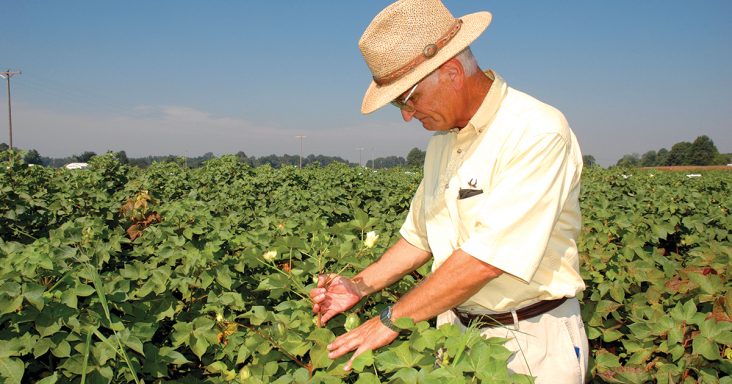Farmers hoping for a ‘Row Crop Renaissance’ in 2021
by April 4, 2021 11:01 am 930 views

As a new decade continues to unfold, there might be a few glimmers of hope for farmers as the spring planting season begins. Wes Ward, Arkansas secretary of agriculture, told Talk Business & Politics he thinks row crop acres, especially soybeans, could rise in 2021.
The largest importer of ag products, China, has committed to buying more than $4 billion worth of U.S. agriculture and there is optimism a long-term trade agreement will be reached between the two countries.
Before the planting season begins, here is a look back at five row crops — soybeans, rice, corn, cotton, and peanuts — that dominate the agricultural fields in the Arkansas Delta.
Soybeans
Arkansas is typically one of the top 10 soybean producing states. The crop has an estimated value of about $1.5 billion to $2 billion each year in the state.
More soybean acres are grown than rice, corn, peanuts, and cotton combined in the state. The 2018 season was one of the worst on record for soybeans and it was followed by the worst year in more than half a century. Soybean farmers dropped their acres by 600,000 to 2.6 million in 2019, after years of remaining above 3 million acres, according to the U.S. Department of Agriculture’s National Agricultural Statistics Service (NASS). It was the lowest number of acres since 1960.
Soybeans rose to about 2.9 million acres in 2020, and Ward thinks the crop could top 3 million acres in 2021.
Rice
Arkansas growers harvested about 1.44 million acres of rice in 2020. It was a nearly 300,000 acre increase from 2019. Row rice, the practice of growing rice using furrow irrigation rather than submerging the plants in a controlled flood, continued to see increased interest and acreage from Arkansas growers in 2020, with an estimated 200,000 acres planted with the method statewide.
A stronger soybean crop could mean that rice acres will drop this year, said Jarrod Hardke, extension rice agronomist for the University of Arkansas System Division of Agriculture.
“Soybean and corn prices have now surged into strong competition with rice acres for 2021,” he said. “Rice acres at this point can be expected to decline slightly, but if those competing commodities remain strong or strengthen in price then it will push rice further down. Right now, a 5-10% decline in rice acres is my expectation. Should soybean prices climb higher, then rice acreage will decline further.”
Cotton
No crop was impacted more by the springtime rains last year than cotton. Planting averages for cotton were well-behind the five-year average as of June 2020.
Farmers ultimately harvested 490,000 cotton acres, a drop of about 120,000 acres from the previous year.
Despite the slow start, Arkansas cotton farmers had somewhat of a comeback year in one respect. Yields approached or exceeded a record-breaking 1,200 pounds per acre, according to NASS. It was about 10 pounds above 2019 yields.
Pigweeds are becoming more herbicide resistant in several counties in Northeast Arkansas, and that could impact planting plans. Dicamba, one of the few herbicides that remain effective against pigweed, can only be used until May under Arkansas Plant Board rules. The board in March started the process to extend the deadline until July 30 for use on cotton crops, but that decision will have to clear multiple hurdles before it goes into effect.
Corn
Corn crops in Arkansas have an annual value of more than $300 million, according to the Arkansas Farm Bureau, and the five-year average of acres is 670,000.
The coming year suggests brighter prospects for Arkansas grain farmers than what befell them in 2020, said Jason Kelley, extension wheat and feed grains agronomist for the University of Arkansas System Division of Agriculture.
“The uptick in corn and grain sorghum prices over the last couple months has been welcome,” Kelley said. The current corn contract price, approximately $4.20 (per bushel) at harvest for next summer, is higher than last year’s market offerings, and will probably increase Arkansas corn acreage above the 620,000 acres that was grown in 2020,” he said.
Peanuts
One of the Natural State’s newest former crops, peanuts, had a banner year in 2020 despite weather problems and a partial replant. A couple of new buying points helped streamline the harvest process.
Arkansas planted around 37,000 acres in peanuts in 2020, up from 2019’s 33,000. Top counties for peanut production in 2020 were Chicot, Clay, Craighead, Greene, Lawrence, Lee, Mississippi, Phillips, Poinsett, Randolph and St. Francis. Yields were up to 5,500 pounds per acre, the highest in the country, Ward said.
Ward believes peanuts will continue to be a viable crop in the Delta after it was reintroduced into the region following test plots planted during the 2010 growing season. Peanut companies began to look for new places to grow peanuts as irrigation became more difficult in places such as Georgia, Oklahoma, and Texas.
Northeast Arkansas has places with rich sandy soil that are ideal for growing peanuts and it has a stable water supply. The only problem is the region’s climate is on the borderline for temperature and weather changes that can impact peanut harvest at the end of the season.
